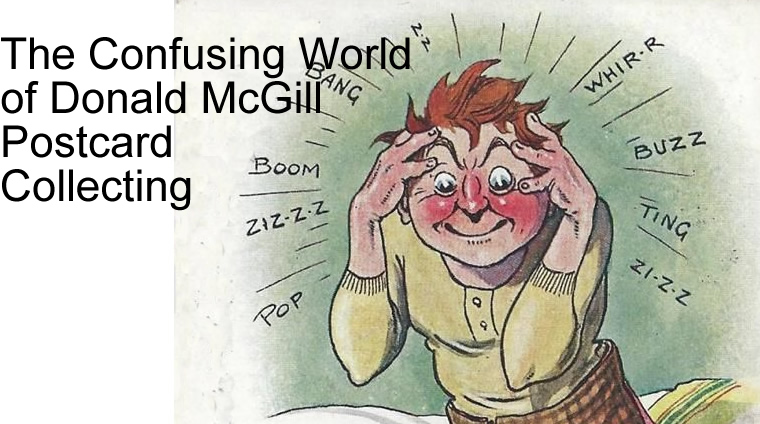When you have collected a few thousand McGill cards you begin to get a feel for which publisher's cards are the more difficult to find. Also, which numerical sequences of cards do not turn up very often.
With McGill's cards for D. Constance Ltd. it is the cards published in 1940 that are more difficult to locate. These are in the 1000 - 1199 number range. This is because the Constance premises at 3-4 Ivy Lane, London EC4 were bombed on the night of 29th December 1940 by the German Luftwaffe.
According to Elfreda Buckland in her book about McGill Joseph Asher made a claim for the damages to the Ivy Lane property which included the loss of 101 original McGill drawings (for which he was awarded £126.12s) and 6000 cards which were in stock.
It seems that McGill redrew some of these lost originals as many Constance cards from the early sequence were republished after the war. (See some of my previous posts which show the difference between the original and redrawn card).
The cards which were drawn specifically about the war - military, blackouts, Hitler themes - were not republished as they were now irrelevant thus ensuring they are now quite rare.
However even rarer than the cards mentioned above are the Constance cards in the sequence 1200 - 1299. It finally clicked with me that not only had I not got any in that number sequence but I didn't recall seeing any. Since I started collecting I have always taken details of every McGill card I came across in an attempt to build up some sort of catalogue but I only had one solitary entry in the 1200 range.
And this is the card:
 |
| D. Constance Ltd. No. 1296 |
I then realised that I already had this card but with a different number and the image was slightly different. Here is the other card:
 |
| D. Constance Ltd. No. 296 |
So it was the same card but McGill had redrawn it. But why had it been republished with the number changed from 296 to 1296 ? As I have shown in other posts on this blog there are many early Constance cards that have been redrawn but they have always been republished with the same number they had originally.
Why was this different and where were all the other cards in the 1200 sequence ?
I was speaking to McGill collector and biographer Bernard Crossley and asked him about the absence of any cards in the 1200s and his simple answer was that there weren't any.
However there is the possibility of one other card existing - numbered 1207 - if it was ever printed and published. One collector has this black and white image (I do not know the story behind this card):
 |
| D. Constance Ltd. No. 1207 (?) |
If this number is correct it begs the question about the cards preceding this one in the sequence.
The last card that I know of in the 1100 sequence is number 1194.
 |
| D. Constance Ltd. No. 1194 |
For whatever reason Constance did not carry on numbering their cards where they had left off when they restarted operations in 1944. They had closed down operations due to the 1940 bombing plus the lack of card and ink needed to publish postcards.
When Constance began publishing again they started their sequence at 1300 and these were a series of birthday greetings cards for children.
 |
| D. Constance Ltd. Nos. 1301, 1302, 1303 |
There is also the theory that the originals destroyed in the 1940 bombing were the complete 1200 to 1299 run which is a very neat explanation as to why they appear to be non-existent.
So, whatever the reason it is very unlikely that any other 1200 cards exist. Should you come across any I'd be very interested to hear about them !
Afterthought:
Strangely there are no 1200 cards in the Joseph Asher & Co. numerical sequence either ! Did Asher have a phobia about the 1200s ?! May not as there are A1200s in the other Asher sequence...












